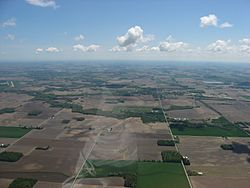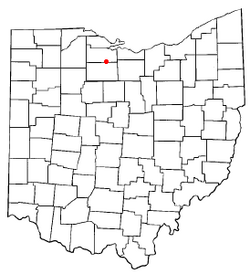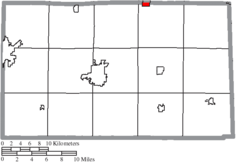Green Springs, Ohio facts for kids
Quick facts for kids
Green Springs, Ohio
|
|
|---|---|
|
Village
|
|

Aerial view of Green Springs and the surrounding countryside
|
|

Location of Green Springs, Ohio
|
|

Location of Green Springs in Seneca County
|
|
| Country | United States |
| State | Ohio |
| Counties | Sandusky, Seneca |
| Area | |
| • Total | 1.16 sq mi (3.01 km2) |
| • Land | 1.16 sq mi (3.00 km2) |
| • Water | 0.00 sq mi (0.01 km2) |
| Elevation | 702 ft (214 m) |
| Population
(2020)
|
|
| • Total | 1,233 |
| • Estimate
(2023)
|
1,222 |
| • Density | 1,062.93/sq mi (410.33/km2) |
| Time zone | UTC-5 (Eastern (EST)) |
| • Summer (DST) | UTC-4 (EDT) |
| ZIP code |
44836
|
| Area code(s) | 419 |
| FIPS code | 39-32256 |
| GNIS feature ID | 1086911 |
| Website | https://www.gsohio.org |
Green Springs is a small village in the state of Ohio, USA. It is located across two counties: Sandusky and Seneca. In 2020, about 1,233 people lived there.
Contents
History of Green Springs
The land where Green Springs is now was once home to the Kaskaskia and Miami Nation people.
In 1817, the Seneca people, who had moved from New York, signed a special agreement called the Treaty of Fort Meigs. This agreement set aside a large area of land, about 40,000 acres, for them. It was called the Seneca Indian Reservation.
Later, in 1831, the Seneca people made another agreement, the Treaty of Little Sandusky. They agreed to give up their land in Ohio. In return, they received new land further west, beyond the Mississippi River. This was part of a bigger plan by the government to move Native American tribes, known as the Indian Removal, during the time of President Andrew Jackson.
In 1831, a person named Jacob Stem bought this land from the government. He bought about 1,200 acres in both Sandusky and Seneca counties. This land included a special sulfur spring. The village was first named Stemtown, after Jacob Stem. Later, it was renamed Green Springs because of the green color of the water from the spring.
Geography of Green Springs
Green Springs covers an area of about 1.21 square miles (3.13 square kilometers). All of this area is land.
State Route 19 goes through the village. The part of the road inside the town is called Broadway Street.
Old train tracks also pass through Green Springs. The Mad River and Lake Erie Railroad used to run here. Today, the Nickel Plate Railroad (now owned by Norfolk Southern) passes along the southern edge of the town.
Environmental Cleanup Efforts
Just north of Green Springs, there was a site where a company called Whirlpool Corporation had disposed of industrial waste. This area was later turned into a park for children. Some people believed that this site might have caused health issues in the community.
Because of these concerns, the park has been closed. Whirlpool Corporation has promised to clean up the site to make it safe for everyone.
People of Green Springs
This section tells us about the people who live in Green Springs and how the population has changed over time.
Population Changes Over Time
| Historical population | |||
|---|---|---|---|
| Census | Pop. | %± | |
| 1880 | 720 | — | |
| 1890 | 910 | 26.4% | |
| 1900 | 816 | −10.3% | |
| 1910 | 833 | 2.1% | |
| 1920 | 830 | −0.4% | |
| 1930 | 750 | −9.6% | |
| 1940 | 930 | 24.0% | |
| 1950 | 1,082 | 16.3% | |
| 1960 | 1,262 | 16.6% | |
| 1970 | 1,279 | 1.3% | |
| 1980 | 1,568 | 22.6% | |
| 1990 | 1,446 | −7.8% | |
| 2000 | 1,247 | −13.8% | |
| 2010 | 1,368 | 9.7% | |
| 2020 | 1,233 | −9.9% | |
| 2023 (est.) | 1,222 | −10.7% | |
| U.S. Decennial Census | |||
Who Lives Here?
According to the census from 2010, there were 1,368 people living in Green Springs. These people lived in 481 homes, and 320 of these were families.
Most of the people living in the village (96.4%) were White. There were also smaller numbers of African American, Native American, and Asian residents. About 8.4% of the population identified as Hispanic or Latino.
In 2010, about 36.2% of homes had children under 18 living there. The average age of people in the village was 40.4 years old. About 24.9% of residents were under 18, and 18.6% were 65 or older.
Education in Green Springs
Green Springs has one elementary school called Green Springs Elementary. It teaches students from kindergarten to fifth grade. This school is part of the Clyde-Green Springs Schools district. Their sports teams are known as the Clyde-Green Springs Fliers.
The village also has a public library. It is a branch of the Birchard Public Library Of Sandusky County.
Famous People from Green Springs
- Ed Pulaski: He was a hero during a big forest fire called the Big Burn. He also invented a special tool for fighting fires, which is now called the Pulaski (tool). He was born in Green Springs.
- Rodger Wilton Young: He received the Medal of Honor, which is a very brave award. He moved to Green Springs when he was ten years old.
See also
 In Spanish: Green Springs (Ohio) para niños
In Spanish: Green Springs (Ohio) para niños

